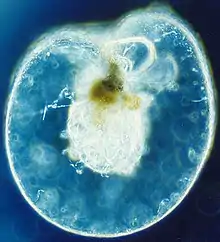| Noctilucales | |
|---|---|
 | |
| Scientific classification | |
| Domain: | Eukaryota |
| Clade: | Diaphoretickes |
| Clade: | SAR |
| Clade: | Alveolata |
| Phylum: | Myzozoa |
| Superclass: | Dinoflagellata |
| Class: | Dinophyceae |
| Order: | Noctilucales Haeckel, 1894 |
| Families | |
|
Kofodiniaceae | |
The Noctilucales are an order of marine dinoflagellates. They differ from most others in that the mature cell is diploid and its nucleus does not show a dinokaryotic organization. They show gametic meiosis.
Characteristics
These cells are very large, from 0.2 to 2 millimetres in diameter, and are filled with large buoyant vacuoles. Some may contain symbiotic green algae, but there are no chloroplasts. Instead, they feed on other plankton, and there is usually a special flagellum involved in ingestion.
Noctilucales reproduce mainly by fission, but sexual reproduction also occurs. Each cell produces numerous gametes, which resemble more typical athecate dinoflagellates and have the dinokaryotic nuclei. Evidence suggests that they diverged from most other dinoflagellates early on, and they are generally placed in their own class.
Taxonomy
- Class Noctiluciphyceae Fensome et al. 1993 [Noctilucae Haeckel 1866; Noctilucea Haeckel 1866 stat. nov.; Cystoflagellata Haeckel 1873 stat. nov. Butschli 1887][1][2][3]
- Order Noctilucales Haeckel 1894
- Family Noctilucaceae Saville-Kent 1881
- Family Kofoidiniaceae Taylor 1976
- Genus Cymbodinium Cachon & Cachon-Enjumet 1967
- Genus Pomatodinium Cachon & Cachon-Enjumet 1966
- Genus Kofoidinium Pavillard 1928
- Family Leptodiscaceae Kofoid 1905
- Genus Abedinium Loeblich & Loeblich III 1966 [Leptophyllus Cachon & Cachon-Enjumet 1964 non Hope 1842]
- Genus Cachonodinium Loeblich III 1980 [Leptodinium Cachon & Cachon-Enjumet 1969 non Klement 1960]
- Genus Craspedotella Kofoid 1905
- Genus Leptodiscus Hertwig 1877 [Pratjetella Lohmann 1920; Clipeodinium Pascher 1917]
- Genus Petalodinium Cachon & Cachon-Enjumet 1969
- Genus Scaphodinium Margalef 1963 [Leptospathium Cachon & Cachon-Enjumet 1964]
- Order Noctilucales Haeckel 1894
Examples
The most common species is Noctiluca scintillans, also called N. miliaris. Blooms of this species are red-orange and can be bioluminescent when disturbed,[4] as are various other dinoflagellates, and large blooms can sometimes be seen as flickering lights on the ocean, known as the milky seas effect.
Another example is Spatulodinium pseudonoctiluca.[5]
References
- ↑ Gómez F (2012). "A checklist and classification of living dinoflagellates (Dinoflagellata, Alveolata)". CICIMAR Oceánides. 27 (1): 65–140. doi:10.37543/oceanides.v27i1.111.
- ↑ Ruggiero; et al. (2015), "Higher Level Classification of All Living Organisms", PLOS ONE, 10 (4): e0119248, doi:10.1371/journal.pone.0119248, PMC 4418965, PMID 25923521
- ↑ Silar, Philippe (2016), "Protistes Eucaryotes: Origine, Evolution et Biologie des Microbes Eucaryotes", HAL Archives-ouvertes: 1–462
- ↑ Eckert R, Reynolds GT (May 1967). "The subcellular origin of bioluminescence in Noctiluca miliaris". Journal of General Physiology. 50 (5): 1429–58. doi:10.1085/jgp.50.5.1429. PMC 2225713. PMID 5340466.
- ↑ Gómez F, Souissi S (March 2007). "The distribution and life cycle of the dinoflagellate Spatulodinium pseudonoctiluca (Dinophyceae, Noctilucales) in the northeastern English Channel". Comptes Rendus Biologies. 330 (3): 231–6. doi:10.1016/j.crvi.2007.02.002. PMID 17434117.
Further reading
- Fernando Gómez; David Moreira; Purificación López-García (2010). "Molecular phylogeny of noctilucoid dinoflagellates (Noctilucales, Dinophyceae)". Protist. 161 (3): 466–478. doi:10.1016/j.protis.2009.12.005. PMID 20188628.
External links
- Noctiluca scintillans — Guide to the Marine Zooplankton of south eastern Australia, Tasmanian Aquaculture & Fisheries Institute
- Haddock SH, McDougall CM, Case JF (May 2011). "Red Tides: Noctiluca Red Tide". The Bioluminescence Web Page.
 Data related to Noctilucales at Wikispecies
Data related to Noctilucales at Wikispecies